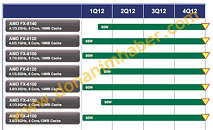Friday, February 17th 2012

Three New, 95 W AMD FX Series Processors Coming Up
Before the end of this quarter AMD is set to introduce a bunch of fresh FX Series chips, including three boasting a 95 W TDP, the FX-4150 quad-core, the FX-6120 hexa-core and the FX-8140 octo-core.
The FX-4150 features a base clock of 3.9 GHz (4.1 GHz Turbo) and 12 MB of cache (4 MB L2 + 8 MB L3) while the FX-6120 has its cores set to 3.5 GHz (4.1 GHz Turbo) and packs 14 MB of cache. As for the FX-8140, it's clocked at 3.2 GHz (4.1 GHz) and has 16 MB of cache. All three models have an AM3+ package and are made using 32 nm process technology. No word on pricing yet.
Source:
DonanimHaber
The FX-4150 features a base clock of 3.9 GHz (4.1 GHz Turbo) and 12 MB of cache (4 MB L2 + 8 MB L3) while the FX-6120 has its cores set to 3.5 GHz (4.1 GHz Turbo) and packs 14 MB of cache. As for the FX-8140, it's clocked at 3.2 GHz (4.1 GHz) and has 16 MB of cache. All three models have an AM3+ package and are made using 32 nm process technology. No word on pricing yet.

34 Comments on Three New, 95 W AMD FX Series Processors Coming Up
B2 Bulldozers are numbered FX-x1xx.
Piledrivers are supposedly FX-x3xx.
So, B3 Bulldozers will be FX-x2xx?
It seems reasonable but reasonableness on this topic doesn't give me much confidence.
Any opinions or scraps of info?
Neither really calculate TDP the same, but intel doesn't include non-core into the figures (aka lying).
Unfortunately, testing this is very hard since intel also draws power besides the 12v rail (really convenient). Intel finally admitted to it and IIRC non-core can consume up to 28 watts as per their documentation (I'm skeptical of anything they say, I don't trust crooks, but it does seem realistic).
You would think total system power consumption could show a clear picture, but it doesn't. With the new FX, power figures are varying greatly, b/c of crap bioses (not sure how much has been fixed). AMD boards seem to be designed a lot different, regardless. The heat produced isn't matching the power figures. If an X6 was really drawing more power than intel's, then how come it runs pretty cool even when OCed? Nothing adds up right. You can't claim an AMD chip is using 250 watts OCed if it's running cool haha. I doubt that the design of the chip can account for using that much power, but not turning it into heat.
If both processors are not comparable in how they use the current provided to it by both the mobo and PSU directly, you cannot compare the power draw, because measuring the powerdraw from the motherboard to the cpu directly cannot be done in any easy way.
and I've measured power consumption of things (usually entire systems like TV, ovens, computers, but not the individual parts that conform them) on several scenarios. I find impressive how energy consumption can drop when using a "low power" energy profile, no matter which system while modern enough (post 2006 I imagine). Its funny how the readings in the clamp meter drop instantly with just a mouse click over energy saving profile, (that if cool n quiet -or the intel equivalent- is enabled of course)
Maybe I should make some tests again and document them. I also did (a long time ago) 80plus vs non-80plus test on the same system and I can't remember a thing.